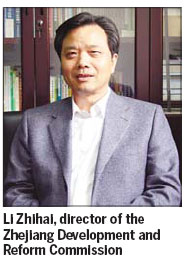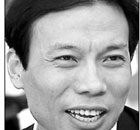Economy
Zhejiang: Economic restructuring will focus on quality
By WANG XIAOTIAN (China Daily)
Updated: 2010-05-01 09:01
 |
Large Medium Small |
HANGZHOU - Zhejiang is at a key stage of its economic development, as the province, which is home to many private enterprises, bounces back from the export gloom caused by the global recession, a senior official says.

"The situation is quite different from a year ago, but economic restructuring is still a top priority. We will focus on growth quality, instead of speed," Li Zhihai, director of the Zhejiang Development and Reform Commission, told China Daily.
In the first quarter this year, Zheijiang's economy reported a 15 percent year-on-year increase in GDP to 536.3 billion yuan, 11.6 percent higher than the same period in 2009. Exports surged 32.4 percent to nearly $36 billion, while investment and consumption increased by 20.5 percent and 18.8 percent, respectively.
Company profits totaled 45.7 billion yuan, a 74.6 percent increase year-on-year, while losses declined by 43.8 percent in the first quarter.
The strong recovery in the outward-looking economy of Zhejiang has triggered doubts on whether government efforts to change the economic structure and upgrade industries can be sustained, with some enterprises returning to low-end, export-oriented businesses such as processing during the recession.
Promote adjustments
"We must avoid any setback or stagnation on structural shift and upgrading. Instead, we will take advantage of the improving economy to promote adjustments without hesitation," Li said.
 A worker on an assembly line in a factory in Fuyang, Zhejiang province. The province's economy has bounced back from the export gloom caused by the global recession. Zhang Zhiping / For China Daily |
In 2009, Zhejiang implemented 264 energy-saving projects in a bid to eliminate outdated production techniques and equipment. It removed and transformed 1,770 industrial boiler units, shut down 800,000-kilowatts of small thermal power capacity and rejected 1,490 projects that did not meet environmental protection requirements.
Development of the service industry, especially the modern logistics sector, is top of Zhejiang's structural change agenda this year.
"One of the most important characteristics of the province's economy is the high proportion of secondary industry and the relatively weak performance of tertiary industry, which need to change for better development," said Zheng Yumin, head of the local industry and commerce administrative bureau.
Li Zhihai said Zhejiang has enjoyed some benefits from last year's economic restructuring as the added value of the tertiary industry increased by 12.5 percent year on year, with its contribution to GDP improving two percentage points compared with that of 2008, while that of the secondary industry dropped slightly to 52 percent.
"The ratio between the two industries is gradually changing and the tertiary industry's contribution to economic growth has improved significantly," Li said.
The government plans to support 10 key service industries as well as 100 key enterprises to form a series of conglomerations this year to promote the sector.
It is also going to increase investment to encourage 146 local leading enterprises to upgrade products, techniques, markets and human resources by offering subsidies and incentives. Last year, Zhejiang invested 500 million yuan to support technological transformation.
Small and medium-sized enterprises (SME), however, could be an obstacle for economic restructuring, due to an unstable external environment and tightening domestic policies adopted to control the risks of inflation and asset bubbles.
"The biggest uncertainty for Zhejiang's economy still lies in export," said Li, warning that even if the government secures a double-digit growth rate for exports, an unclear situation in the world economy will greatly affect the region's performance and threaten the survival of SMEs.
Zhejiang accounted for one-tenth of the 9.59 trillion yuan of new lending in 2009, double that of the previous year, which made the province "very sensitive to the tightening measures introduced by the central government since late 2009 to control excess liquidity", Li said.
Total bank lending in February was 700 billion yuan, half of January's level, after regulators tightened credit controls, the central bank said. New lending in March shrank by 27 percent month-on-month to 510.7 billion yuan, figures released by the National Statistics Bureau on April 15 showed.
Any yuan appreciation would also strike local export-oriented industries a heavy blow, Li said.
"Add on surging raw material prices and labor costs, and the financing difficulties of SMEs will become more acute," he said.
As for solutions, Li preferred to encourage local banks to change their credit structure and lend more money to SMEs.
In the first quarter, new lending to SMEs in Zhejiang reached 170.3 billion yuan, representing more than 50 percent of the region's total new credit during that period.
"Another way to solve the problem is to develop small and medium-sized credit organizations and set up special SME credit guarantee institutions," he said, adding that surging private investment could also be guided to local enterprises.
Investment
Nationwide private investment increased by 30.4 percent in the first quarter this year, marking the fastest flip since December 2008, said the central bank on April 23. During the same period, State-controlled investment increased by 21.1 percent.
Private investment in Zhejiang began to come alive in the first quarter, rising 29.6 percent year-on-year, among which investment in manufacturing increased by 20.6 percent, according to the local statistics bureau.
Xu Jianfeng, head of the Economic Research Institute under the Zhejiang Academy of Social Sciences, said widespread research and development weaknesses among local enterprises also need to be addressed as the export-orientation, processing and SME featured economy restructures.
"By improving industrial restructuring and productivity, we hope a dumbbell-shaped mode will surface," said Li Zhihai, adding that sustaining the quality of economic growth was essential to ensure the province's long-term prosperity.
CHINA DAILY







